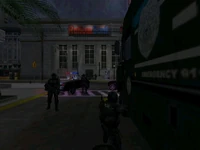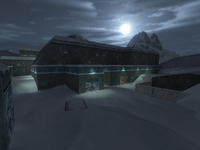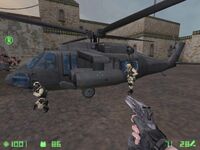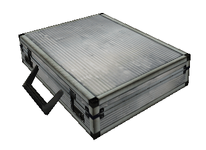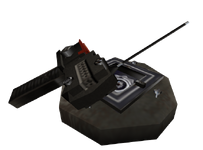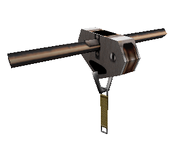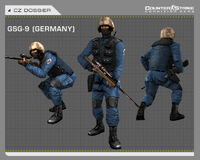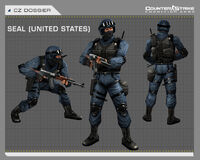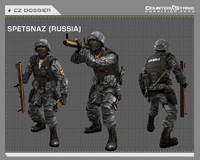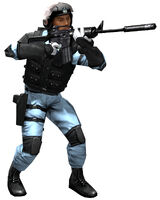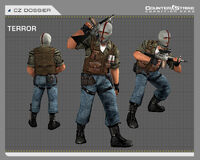- For the single-player component released separately by Valve Software, see Counter-Strike: Condition Zero Deleted Scenes.
The third iteration of Counter-Strike: Condition Zero was developed by Ritual Entertainment. Their single-player design was a very traditional linear shooter complete with cutscenes and scripted sequences, much like Half-Life.
Most of the work done by Ritual Entertainment was eventually released as Counter-Strike: Condition Zero Deleted Scenes. Other pieces of their work found their way in a slightly modified form into the final version of Counter-Strike: Condition Zero.
Development
Following Electronic Arts decision to cancel the PC port of The Lord of the Rings: The Two Towers in early August 2002,[1] Ritual Entertainment was left in a difficult situation. The Two Towers had been a very lucrative project for Ritual Entertainment,[2] allowing the company to grow to include over 50 employees.[3] However, when this project was cancelled, a large part of this expensive team was left without a project to work on.[2]
Only weeks earlier, Gearbox Software had decided to withdraw from the development of the Counter-Strike series,[4] thus Valve Software was on the hunt for a new developer to work on both Counter-Strike: Condition Zero and Counter Strike Xbox.[5] The timing was perfect for Ritual Entertainment, and in mid-August an agreement was reached whereby Ritual would take over further development of Condition Zero and Counter-Strike Xbox.[6][5]
Valve Software had given quite specific specifications for Ritual Entertainment regarding the single-player design:[7] a Half-Life meets Counter-Strike type of experience.[8] This meant a very traditional linear shooter sporting scripted sequences and cutscenes for providing narrative. The game was redesigned from scratch by Valve and Ritual, but some of the content previously created by Gearbox Software was incorporated into this new design.[9][10]
While the primary focus of Ritual Entertainment was the development of a comprehensive single-player game, multiplayer was not neglected. The plan was to provide an enhanced multiplayer experience in the form of upgraded character models, weapon models and new multiplayer maps.[11] Valve Software also contracted Michael Booth's company Turtle Rock Studios to create a new bot from scratch for the multiplayer experience.[12]

Ritual Entertainment CEO Steve Nix at the CPL winter event.
On December 6, 2002, Ritual Entertainment's involvement in the game development was first revealed to the public,[13] and only a week later their new design of the game was unveiled to the public.[14] The game would also be showcased at the Cyberathlete Professional League (CPL) winter tournament on December 20 in the form of a hands-off demo.[3][2] The first official trailer was also released on the very same day.[15]
At this stage, the game was revealed to feature 20 single-player missions and 10 new multiplayer maps.[3] In addition, around 10 new pieces of weapons and equipment were to be added to the single-player game.[16] For the multiplayer game, 2 new factions were promised.[17] The game was scheduled to be completed by May 2003.[10]

Project manager Erik Johnson at Vivendi Universal Games Faire.
On February 25, the game was showcased at the Vivendi Universal Games Faire held in Berlin, Germany.[18] Unlike the previous showcase at the CPL event, attendants were given the opportunity to play a demonstration of the game themselves. However, the demonstration was a very limited, showcasing only the new arsenal and the upgraded player models.[19]
In early April, a new trailer of the game was released exclusively by Computer Gaming World.[20] This trailer was included on the cover CD of the May 2003 issue.

Counter-Strike: Condition Zero booth at E3 2003.
The game would also make an appearance at E3 in May 2003. At the show, the game was presented at Vivendi's booth in a relatively small area where a non-interactive but quite extensive demo of the single-player game could be watched.[21][22] It was also possible to play a multiplayer game against the bots on a separate computer.[21] Some slight changes in the design were also announced, which included dropping the number of mission to 19 from the previous 20.[23] On the other hand, the number of factions for multiplayer games had been increased to six per team.[24][25] It was also revealed that the single-player game would feature a total of 7 Counter-Terrorist factions.[23] The game also appeared to be almost on schedule, as a release candidate of the game had been shipped off and the game was stated to be "98% complete".[23][26]
In June 2003, Ritual Entertainment once again encountered financial trouble. They had finished another project they were working on, Star Trek: Elite Force II, and were unable to secure a new project. This resulted in a large lay-offs at Ritual Entertainment,[27] and affected at least Mike Porter, Chris Voss and Luke Whiteside from the Condition Zero team.[28] It was stated that this wouldn't affect the development of Condition Zero,[27] most likely due to the fact that Ritual Entertainment would complete its development on the title in June, 10 months after starting development on the title.[29]
While it was stated in May that a release in June was likely, no news regarding the status of the game were revealed and the game had no longer had an official release date.[30] Ritual Entertainment had hoped that the game would have been released in June as it would have meant a boost in European sales, but releasing the game was out of Ritual's control.[31] The media silence was likely caused by the fact that the game was to undergo final polishing at Valve, but internal play testing had revealed that the game as designed by Ritual Entertainment had serious issues and wasn't up to the quality standard expected by Valve.[32] Further negative attention was attracted by the game in July, when several gaming magazines in Europe received review copies of the game and published very mediocre reviews of the game.[33][34]
Unbeknownst to Ritual Entertainment and the public, Valve Software decided to redesign the game in June 2003 based on all the negative attention the single-player mode had attracted.[32] This time Turtle Rock Studios was put in charge of game design due to the fact that the bot included with the game had been very well received.[35]
The game as designed by Ritual Entertainment would still be showcased by Vivendi at the Leipzig Games Convention held in late August.[36] In early September, publisher Sierra also released a new trailer showcasing the game.[37] Both of these occurrences suggest that Valve Software didn't even inform the publisher of the ongoing redesign of the game.
Despite Ritual's work getting scrapped, most of the work they did for the single-player game would eventually get released as part of Counter-Strike: Condition Zero Deleted Scenes. Much of the multiplayer content would also find its way to the final version of Counter-Strike: Condition Zero.
Game modes
While the design of the game was primarily focused on single-player, a multiplayer component would also be included.
Single-player
“We are spending most of our time sculpting our levels full of fun gameplay and scripted events.”
―Robert Atkins[11]
Ritual Entertainment was contracted by Valve Software to develop a very traditional linear single-player experience or the game. Originally, there was to be a total of 20 missions which were detached in terms of narrative.[14] The decision to make the missions unconnected was made based on the multiplayer experience of Counter-Strike, where the player is dropped into detached maps.[9] The amount of missions was later dropped to 19.[23]
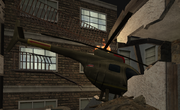
Helicopter crash serving as a key moment in Run!
The focus on mission design was the creation of key moments, which were memorable cutscenes or scripted sequences that would occur in the mission.[38] Each mission was to feature at least one major key moment and several minor ones to help immerse the player into the single-player experience.[39][16]
The AI utilized by enemies was based on the AI that already existed in the GoldSrc engine.[11] However, significant updates were made to the AI to improve the single-player experience of the game.[14]
Originally, the design of the game did not include First Aid Kits or the ability to replenish armor to stay true to the original Counter-Strike. However, during play tests it became apparent that the design of the game would have made missions very difficult to complete and the decision was made to introduce health kits and armor replenishment into the game.[40]
It was also decided that the player would not be allowed to pick up ammo or weapons from dead enemies. This was done to strengthen the feeling that the player was part of a special forces unit with its own weapons and items.[41]
Multiplayer
“[We are] sticking to the rules that were set up in [Counter-Strike].”
―Tom Mustaine[42]
Just like in Gearbox Software's design, plans were to issue a patch which would make the multiplayer component of Condition Zero compatible with the original Counter-Strike.[11] However, the improved models and sound effects would remain exclusive to owners of Condition Zero.[3] The bot was also going to be exclusive to owners of Condition Zero.[24]
Originally, there were plans to release the new multiplayer maps to the original Counter-Strike gradually as free updates.[3] This meant that initially, some of the new maps could only be played by owners of Condition Zero.[42] However, later on it was mentioned that the new maps would remain exclusive to owners of Condition Zero.[23]
Ritual Entertainment was only in charge of upgraded models and new content for the multiplayer game. Actual code changes and decisions regarding the introduction of new weapons were up to Valve Software.[43]
Scenarios
Ritual Entertainment had plans to support the three most popular multiplayer scenarios (hostage rescue, bomb defusal and assassination) with enhanced and additional content. Escape was not going to be supported since it was essentially a dead scenario.[44]
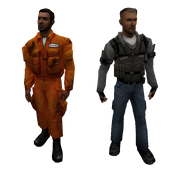
New maps were going to be included for all three scenarios.[44] While several different hostage models had been created by Ritual Entertainment for the single-player experience, it was never stated whether there were plans to introduce map specific hostages (like in the Xbox version) or if the regular hostage model would simply be improved upon. The generally quite conservative approach regarding multiplayer changes support the theory that the hostage models were simply going to be upgraded. A new model was also created for the VIP.
No actual gameplay changes or new scenarios were announced, likely because it had been decided that the standard formula used in the original Counter-Strike would be followed and since Ritual Entertainment had limited possibilities to influence the multiplayer component.[42][43]
Maps and missions
Ritual Entertainment designed both new missions for the single-player game and new maps for the multiplayer mode. The level design on the title was overseen by industry veteran Richard Gray, who was the lead level designer.
Since a lot of content had already been created previously by Gearbox Software, Ritual decided to use some of this existing content when working on the new maps and missions.[2] However, it would seem that Ritual Entertainment did not have access to the actual source files for some of the maps and decompilation was necessary.[45][46] Whether this was due to incompatibilities with the map format used by Gearcraft, the custom map editor by Gearbox Software, or because of never receiving the actual source files is not known.
There were originally plans for the game to feature a total of 20 single-player missions.[3] Later during development, this amount was dropped to 19.[23] While using map geometry previously designed by Gearbox Software as a base provided a good starting point,[47] major expansion was necessary as the new missions were much larger in size than traditional multiplayer maps.[2]
There were at least three more missions on the drawing board since the Xbox version of the game was going to feature a total of 22 missions plus a bonus space station mission. However, these missions were to remain exclusive to the Xbox version.[48]
On the multiplayer side, a total of 10 new maps were to be featured in the game.[3] While it was stated that many multiplayer maps would be cut-down versions of the single-player missions,[9] only two such maps are known to have existed. The majority of the new multiplayer maps were either inherited from Gearbox Software's design or were original maps made from scratch.
Notably, Ritual Entertainment had no plans to release the multiplayer map remakes created for Counter-Strike Xbox with Condition Zero. These remakes were to remain exclusive to the Xbox port of the game.[49]
List of missions
The listing below includes all known single-player missions that Ritual Entertainment was working on during their development of Counter-Strike: Condition Zero. Ritual's version of Condition Zero had a different mission progression to that of Counter-Strike: Condition Zero Deleted Scenes.[41] This original order is also listed.
| Map name | Organization | Designer | Based on | No.[n 1] |
|---|---|---|---|---|
| Alamo | SEAL Team 6 | Richard Gray | Damage | 15 |
| Building Recon | SAS | Russell Meakim | Vostok | 06 |
| Counter Terrorist Training | SEAL Team 6 | Reid Kimball, Tom Mustaine | Original | - |
| Downed Pilot | GSG-9 | Thearrel McKinney Jr. | Enemymine | 10 |
| DrugLab | SEAL Team 6 | Thearrel McKinney Jr. | Junglecamp | 07 |
| Fastline | Kidotai | Luke Whiteside | Original | 01 |
| Hankagai | Kidotai | Todd Rose | Hankagai | 11 |
| Lost Cause | GSG-9 | Luke Whiteside | Original | 03 |
| Miami Heat | SEAL Team 6 | Thearrel McKinney Jr. | Original | 17 |
| Motorcade Assault | GSG-9 | Chris Voss | Bridge | 08 |
| Pipe Dream | Spetsnaz | Mike Porter | Pipeline | 05 |
| Recoil | SEAL Team 6 | Luke Whiteside | Dahab | 02 |
| Rise Hard | SAS | Russell Meakim | Genoserv | 16 |
| Run! | Kidotai | Todd Rose | Rooftops | 13 |
| Sandstorm | SAS | Richard Gray | Original | 14 |
| Secret War | Spetsnaz | Russell Meakim | Silo | 04 |
| Sniper | GIGN | Thearrel McKinney Jr. | Unknown | Cut |
| Thin Ice | Spetsnaz | Russell Meakim | Vessel | 09 |
| Truth in Chaos | Kidotai | Todd Rose | Toruko | 18 |
| Turn of the Crank | SWAT | Richard Gray | Original | 12 |
List of maps
The listing below includes all known multiplayer maps that Ritual Entertainment was working on during their development of Counter-Strike: Condition Zero. It was mentioned that 10 multiplayer maps were to be featured,[3] indicating that several of these maps were cut when Ritual was still working on the game.
*Quarry was never worked on by Ritual Entertainment, but it was featured in review copies of their version of Condition Zero.[33]
Weapons and equipment
Around 10 pieces of equipment and weapons were introduced in Ritual Entertainment's design of Counter-Strike: Condition Zero.[16]
Weapons
A total of 7 weapons are known that were considered for inclusion into the iteration of Condition Zero designed by Ritual Entertainment. All of these weapons seem to have been inherited from the game design by Gearbox Software. Some of these new weapons would get introduced into the original Counter-Strike through an update. Further weapons were going to be released to multiplayer mode at a later date.[14] At least the General MG 60 was seriously being considered for inclusion in the multiplayer mode.[48] On the other hand, it was said that the LAW Rocket would likely not be included in multiplayer.[3]
In addition to introducing brand new weapons, all original Counter-Strike weapon models were recreated with a polygon count increase of roughly 66 percent.[24] To ensure compatibility with the original Counter-Strike these new weapon models were modeled as left-handed, just like the original weapon models.[50] Due to time constrains many of the weapon animations were only tweaked from the originals instead of being remade from scratch.[51]
Perhaps the most surprising change was the introduction of a weapon attached flashlight on select guns. This replaced the default flashlight in an effort to increase realism as the original flashlight was part of the HEV suit in Half-Life, which didn't make sense for a Counter-Terrorist operative.[52] It was stated that this change would also make its way to the multiplayer game.[48]
| Clarion 5.56 | ||
|---|---|---|
| Type: | Rifle | |
| Side: | Counter-Terrorists | |
| The Clarion 5.56 or FAMAS is a weapon that was inherited from Gearbox Software's design of Counter-Strike: Condition Zero. This weapon provided a cheaper alternative to the Maverick M4A1 Carbine. It would eventually get introduced to the multiplayer game via the Counter-Strike 1.6 update before Condition Zero was released. | ||
| Gas Grenade | ||
| Type: | Grenade | |
| Side: | Unknown | |
| The gas grenade was likely inherited from Gearbox Software's design of Counter-Strike: Condition Zero. Its purpose or function in Ritual Entertainment's design of the game was never revealed as the grenade had already been removed from the game by the time the game was unveiled to the public.[14] | ||
| General MG 60 | ||
| Type: | Machine gun | |
| Side: | Both[53] | |
| The M60 machine gun was likely inherited from Gearbox Software's design of Counter-Strike: Condition Zero. It does higher damage than the M249, but it also has higher recoil. | ||
| IDF Defender | ||
| Type: | Rifle | |
| Side: | Terrorists | |
| The IDF Defender or Galil is a weapon that was inherited from Gearbox Software's design of Counter-Strike: Condition Zero. This weapon provided a cheaper alternative to the CV-47. It would eventually get introduced to the multiplayer game via the Counter-Strike 1.6 update before Condition Zero was released. | ||
| LAW Rocket | ||
| Type: | Grenade | |
| Side: | Both[53] | |
| The M72 LAW was likely inherited from Gearbox Software's design of Counter-Strike: Condition Zero. It is a single shot weapon, and it will automatically be disposed of after being fired. Before the weapon can be fired, a quite long deploying process takes place. | ||
| Machete | ||
| Type: | Melee weapon | |
| Side: | Unknown | |
| The Machete was likely inherited from Gearbox Software's design of Counter-Strike: Condition Zero. It was possibly acquirable very early in design,[54] as its presence in the game was never even mentioned. However, it was going to be acquirable in the Xbox port of the game.[48] Despite the player not being able to receive the weapon, enemies still use it. | ||
| Tactical Shield | ||
| Type: | Equipment | |
| Side: | Counter-Terrorists | |
| The Tactical Shield is a defensive piece of equipment that was inherited from Gearbox Software's design of Counter-Strike: Condition Zero. Just like in Gearbox Software's version, this too is limited to be used only in conjunction with the ES Five-Seven. It would eventually get introduced to the multiplayer game via the Counter-Strike 1.6 update, where the specific pistol restriction was removed. | ||
Mission equipment
The new pieces of equipment were very single-player oriented making it impossible to introduce these to a multiplayer setting. Most of these equipment types were restricted to be used in specific zones. This restriction was put in place to mitigate fears of breaking puzzles or game play.[9]
| Blowtorch | ||
|---|---|---|
| Type: | Anti-barricade equipment | |
| Game mode(s): | Single-player | |
| The blowtorch is a special piece of equipment which can be used to break locks which hinder the progress of the player. It can only be used in specific blowtorch zones. | ||
| Briefcase | ||
| Type: | Signaling equipment | |
| Game mode(s): | Single-player | |
| The briefcase is a special piece of equipment which is designed to send a radio signal when opened, altering of eventual distress. Inside the briefcase is what appears to be regular money to avoid raising suspicion. It can only be used in specific briefcase zones. | ||
| Fiber Optic Camera | ||
| Type: | Surveillance equipment | |
| Game mode(s): | Single-player | |
| The fiber optic camera is a special piece of equipment that can be used to monitor enemy movement without the risk of being spotted. It can only be used in specific fiber optic camera zones. | ||
| Portable Medkit | ||
| Type: | Medical equipment | |
| Game mode(s): | Single-player | |
| This piece of equipment likely going be an inventory item providing a means of limited health restoration without having to find a regular First Aid Kit or a Wall attached medkit. It was removed very early in design, since it was never mentioned in any preview and no models for it were ever completed. Its inclusion might have been inspired by another title Ritual was working on at the time, Star Trek: Elite Force II, which featured a portable medkit. | ||
| Radio | ||
| Type: | Signaling equipment | |
| Game mode(s): | Single-player | |
| The radio is a special piece of equipment that is used to contact squad members in order to provide valuable intelligence. It can only be used in specific radio zones. | ||
| Radio Controlled Bomb | ||
| Type: | Anti-barricade equipment | |
| Game mode(s): | Single-player | |
| The radio controlled bomb is a special piece of equipment that is used to destroy specific targets in a mission. These may include barricades which prevent further progress or objects which are the target of a mission. It can only be used in specific radio controlled bomb zones. | ||
| Satellite Enabled Digital Camera | ||
| Type: | Surveillance equipment | |
| Game mode(s): | Single-player | |
| The camera is a special piece of equipment that is used to take photos of mission critical targets. Since the camera is satellite enabled, pictures taken will be automatically sent to headquarters. It can only be used in specific camera zones. | ||
| Syringe Gun | ||
| Type: | Medical equipment | |
| Game mode(s): | Single-player | |
| The syringe gun was likely present very early in design[55] as its presence in the game was never even mentioned. However, it was going to be acquirable in the Xbox port of the game.[48] It could only be used in specific syringe gun zones. | ||
| Zip Line | ||
| Type: | Maneuvering equipment | |
| Game mode(s): | Single-player | |
| The zip line was a special piece of equipment that was to be ridden around the periphery of the building in Rise Hard in order to overcome obstacles.[48] It would seem the design of the map was later changed as the final version of the map features no zip lines, thus this piece of equipment became unnecessary. | ||
Factions and player models
When originally unveiled, Ritual Entertainment's design inherited the Russian Spetsnaz Counter-Terroist faction and the American Militia Terrorist faction from Gearbox Software's iteration of the game.[17] However, in May 2003 it was revealed that there would be six factions for each side.[24][25] The sixth Counter-Terrorist faction was going to be the Kidotai,[23] and the sixth Terrorist faction was to be the Drug Lord.[48] It would seem that the Drug Lord faction was later replaced with a Japanese Terrorist faction, the Akunin (or Aum Shinrikyo which is mentioned in the strategy guide[53]). It is possible that Akunin and Aum Shinrikyo were alternate names for the same faction since the inclusion of two different Japanese terrorist factions seems unlikely.
Gearbox Software had already created updated player models for their iteration of the game, however Valve Software felt that these models looked too different from the originals and that it was difficult for new players to distinguish between Terrorists and Counter-Terrorists.[56] Therefore, Valve asked Ritual to remake the models with a look more similar to the original models.[56] In addition, Ritual also gave each model more distinct silhouettes to make it even easier to distinguish between the sides.[24] Compared to the original player models in Counter-Strike, these remade models had an increase in polygon amount of around 66 percent.[24]
Like Gearbox Software before them, variation in the player models was to be introduced in the form of alternate looks. Both variants to the head model and camouflage were created. Unlike the previous design by Gearbox Software, Ritual Entertainment also created camouflage-like uniforms for the Terrorists.
In multiplayer however, each faction would have just one look and some of these models were revealed via an update to the official website. This line-up wasn't the final one, as the Midwest Militia and Elite Crew models were going to be switched around and the Elite Crew model was to receive a new head model. The reason for this last minute change was that the previous models looked too different from the ones in the original Counter-Strike.[26]
Music and sound effects
Ritual Entertainment employee Zak Belica was responsible for the new music and sound effects in Counter-Strike: Condition Zero. Each mission has several music tracks that will play in different parts of the map. In addition, all sound effects from the original Counter-Strike were enhanced to 16 bit sound quality.[57][14]
Interface

World map
Counter-Strike: Condition Zero would utilize the new VGUI 2.0 interface technology,[14] which replaced the old fixed-resolution main menu that originated from the retail version of Half-Life. This new interface was first introduced in Counter-Strike 1.6.[10]
A world map view was also introduced for the single-player component, from where missions that had been unlocked could be started.
In addition, perhaps the biggest change was the decision to make the game UI have a greenish color.
Technology
Since Counter-Strike: Condition Zero was meant to be compatible with the original Counter-Strike, limited changes were made to the game engine. However, various smaller tweaks were made in an effort to increase the visual appeal of the game.
Bots
Bots for the iteration of Counter-Strike: Condition Zero designed by Ritual Entertainment were provided by Michael Booth of Turtle Rock Studios.[12]
While a bot had already been developed by Gearbox Software for their iteration of the game, this bot was scrapped and Michael Booth started from scratch as he had a quite different approach for creating the bot.[12] Unlike any other bot until now, this bot had the capability of automatically learning new maps, making it possible to use it on most custom maps without requiring intervention by the user.[12]
Originally, bots were to be named according to their difficulty. Bots having names starting with the letter A would be the toughest, while bots having names starting with the letter Z would be the weakest.[24]
This bot would end up getting beta tested by the public in the original Counter-Strike between June 5, 2003 and September 9, 2003.[58][59]
Visual effects
A completely new particle system had been created for the game during the development of Condition Zero, which allowed for more impressive explosions and a variety of dust and snow efffects. This particle system was eventually released for the original Counter-Strike as well with the 1.6 patch.[14]
Another visual enhancement was the introduction of a material system. Such a system already existed in the previous iteration of the game. This system allows material specific debris to be defined, giving numerous options for defining the behavior of spawned gibs. It is not known if this enhancement was ever being considered for inclusion to the multiplayer mode.
While no new physics engine was introduced into the game, the artists at Ritual Entertainment designed numerous death animations for enemies which in combination with scripting introduced "rag-doll like" death effects into the game.[38]
Mapping, modding and editing tools
A new scripting language was introduced to the single-player missions, which had the advantage of allowing modifications to scripted sequences without having to recompile the whole level.[9] It also made it easier to coordinate localizations and event timings.[16]
Ritual Entertainment used a custom modification of QERadiant, a Quake 3 editor, for creating the maps for Counter-Strike: Condition Zero. There were plans to release this custom version of the editor to the community after with release of the game.[2]
Content delivery and anti-cheat
Counter-Strike: Condition Zero was to be released via Steam and at retail.[10] In addition to providing a content delivery system and a means of updating the game, the anti-cheat technology provided by Steam was also to be utilized.[60]
Marketing and merchandise
As the game developed by Ritual Entertainment was very close to being completed by the time it was cancelled, publisher Vivendi Universal Games had already started a marketing campaign for the game due to its impending release.

Condition Zero magazine advertisement
While the extent of this marketing campaign is not completely known, advertisements for the game were featured in some magazines.[61] The box art had also been finalized and the game had been rated by the ESRB receiving a rating of mature. As an additional incentive for pre-ordering the game, special trading cards were also produced.[62] In early September, Vivendi subsidiary Sierra also released a new trailer showcasing the game.[37]
It was also revealed that exclusive footage of Half-Life 2 would be bundled with the game, likely in an attempt to attract Half-Life fans.[63] Shortly after this was unveiled, Gabe Newell clarified that the footage actually originated from the E3 2003 showcase of Half-Life 2.[64]
Finally, the official strategy guide for the game had also been completed by Prima Games and copies of it had been sent to some retailers. However, it was never actually sold as the distributor was waiting for the game to be released before giving retailers permission to sell the guide.[65]
Reception
| Review scores | |
|---|---|
| Publication | Score |
| GameStar | 59/100[33] |
| PC Gamer (UK) | 65/100[34] |
| PC Zone | 79/100[66] |
| Average: 68/100 | |
Despite the game never reaching gold status, Valve Software handed out review copies to select gaming publications in Europe in late July 2003.[67]
The press was unanimous in the opinion that the single-player mode of the game had several issues. One aspect that was criticized was the AI, particularly that of team mates. Martin Konda of PC Zone stated that "you single-handedly fight to thwart terrorist cells, while a handful of brain-dead AI team-mates stand around looking at flowers". As for the enemy AI, Konda thought the enemy AI was sporadically impressive, being able take cover when under fire and running away from grenades. Matt Pierce of PC Gamer also noticed some moments of impressive AI action, but in overall felt that the AI was seriously lacking.
Pierce thought that the level design was above average, sporting beautiful architecture. However, the levels were too linear to his taste. Martin Konda on the other hand thought that the missions were far too scripted and the inclusion of new mission specific equipment was pointless since they could only be used in marked zones.

Review copy receipt with billing reference "CZ review copy"
Unlike the single-player, the multiplayer component received applause and it was the main reason PC Zone gave such a high score for the game. PC Gamer also increased the score by 10% due to the excellent multiplayer component. GameStar decided to review the single-player and multiplayer modes separately, giving the single-player a mere 59/100 while scoring the multiplayer mode 88/100.
Ritual Entertainment responded to the critique the single-player mode had received by stating that the copies received by the press were not final code and were not meant to be reviewed.[68] One employee of Ritual even called the magazines unprofessional for doing these reviews.[68] However, the dispatch note that accompanied the copies Valve had sent to the magazines clearly stated they were meant for review purposes.[67]
Legacy
Despite Ritual Entertainment being removed from the Counter-Strike: Condition Zero project, most of their work would eventually get released:
- A cut-down version of the single-player component modified by Valve Software was eventually released as Counter-Strike: Condition Zero Deleted Scenes. Over time, the six missions that had been cut from Deleted Scenes would get released as bonus missions.
- Both the enhanced player and weapon models were slightly modified and patched into the final version of Condition Zero.
- The bots originally designed to complement the work Ritual Entertainment had done would go on to play a key role in the final iteration of Condition Zero by Turtle Rock Studios.
- The box art that had been completed for this iteration of the game would get used by the final game. Thus, Turtle Rock Studios wouldn't have their logo present on the game box.
- The trading cards initially created to promote this version of the game would eventually included as a pre-order incentive for the final version of Counter-Strike: Condition Zero
- The official strategy guide by Prima Games was likely edited to remove the six missions not initially part of Deleted Scenes and content pertaining to the Tour of Duty mode was added
Trivia
- Early screenshots and the first trailer show enemies armed with MP5 SD or SPAS-12. These were placeholder weapons that were used before the actual weapons had been implemented into the game.[52]
References
- ↑ IGN: Two Towers Cancelled?
- ↑ 2.0 2.1 2.2 2.3 2.4 2.5 Shacknews Article - Counter-Strike: Condition Zero (Ritual Entertainment). Archived from the original on 2003-01-27.
- ↑ 3.0 3.1 3.2 3.3 3.4 3.5 3.6 3.7 3.8 GameSpot - Counter-Strike: Condition Zero details
- ↑ .plan File for Randy Pitchford
- ↑ 5.0 5.1 Ritualistic Articles - Counter-Strike: Bringing the World's Most Popular Shooter to Xbox Live
- ↑ Ritualistic Forums - wow
- ↑ Ritualistic Forums - The CS:CZ models
- ↑ Ritualistic Forums - Accurate Press?
- ↑ 9.0 9.1 9.2 9.3 9.4 Gamehelper.com - Counter-Strike: Condition Zero Interview. Archived from the original on 2003-04-18.
- ↑ 10.0 10.1 10.2 10.3 HomeLan Fed : Exclusives : Counter-Strike: Condition Zero Interview. Archived from the original on 2002-12-27.
- ↑ 11.0 11.1 11.2 11.3 ComputerAndVideoGames.com - Interview: Ritual chats about Counter-Strike: Condition Zero. Archived from the original on 2007-09-11.
- ↑ 12.0 12.1 12.2 12.3 HomeLan Fed : Exclusives : Official Counter-Strike Bot Interview. Archived from the original on 2003-04-26.
- ↑ Shacknews | Ritual's Condition Zero.
- ↑ 14.0 14.1 14.2 14.3 14.4 14.5 14.6 14.7 GameSpy.com - Preview - Counter-Strike: Condition Zero (PC). Archived from the original on 2002-12-21.
- ↑ FileShack.com | Counter-Strike: Condition Zero Trailer. Archived from the original on 2003-01-11.
- ↑ 16.0 16.1 16.2 16.3 PC Zone - PC Preview: Counter-Strike: Condition Zero. Archived from the original on 2007-05-28.
- ↑ 17.0 17.1 ComputerAndVideoGames.com - Interview: Zero hour approaches. Archived from the original on 2007-09-10.
- ↑ Worthplaying | Vivendi Universal Games' 2003 LineUp
- ↑ Games Domain - Vivendi Universal Games Faire 2003 Part 2. Archived from the original on 2003-03-04.
- ↑ Ritualistic Forums - 21 CGW Trailer Screenshots (481 KB)
- ↑ 21.0 21.1 CS-Nation - articles - e3 impressions. Archived from the original on 2003-06-01.
- ↑ 4Gamer.net - [E3 2003#110]「Counter-Strike Condition Zero」の直撮りムービーをUp
- ↑ 23.0 23.1 23.2 23.3 23.4 23.5 23.6 GameSpy Presents: E3 2003 -- Counter-Strike: Condition Zero (PC). Archived from the original on 2003-12-07.
- ↑ 24.0 24.1 24.2 24.3 24.4 24.5 24.6 IGN - PC Games: Condition Zero. Archived from the original on 2003-05-08.
- ↑ 25.0 25.1 Ritualistic Forums - CSX Previews Follow-up
- ↑ 26.0 26.1 Ritualistic Forums - Great, another cz delay...
- ↑ 27.0 27.1 GameSpyDaily - Ritual lays off Elite Force 2 team. Archived from the original on 2003-07-01.
- ↑ Ritualistic Forums - Ritual Layoffs
- ↑ Ritualistic Forums - Stop misleading people!!
- ↑ CS-Nation - CS:CZ Release Date. Archived from the original on 2003-12-11.
- ↑ Ritualistic Forums - http://www.ritualistic.com/forums/showthread.php?t=12557
- ↑ 32.0 32.1 GameSpot - Condition Zero commotion has golden ending
- ↑ 33.0 33.1 33.2 GameStar - September 2003 (2003) IDG Entertainment Verlag GmbH.
- ↑ 34.0 34.1 PC Gamer - Counter-Strike: Condition Zero Review. Archived from the original on 2003-08-26.
- ↑ HomeLAN Fed : Exclusives : CS: Condition Zero-Turtle Rock Studios Interview. Archived from the original on 2004-04-22.
- ↑ GamersHell.com - Day 1: Leipzig Games Convention 2003 Report
- ↑ 37.0 37.1 CS-Nation - cs:cz video. Archived from the original on 2003-12-11.
- ↑ 38.0 38.1 The Adrenaline Vault | Exclusive Preview of Counter-Strike: Condition Zero. Archived from the original on 2003-02-17.
- ↑ Computer Gaming World - Issue 226 (2003-05) Ziff Davis Media Inc.
- ↑ Ritualistic Forums - Medikits in single-player.
- ↑ 41.0 41.1 Ritualistic Forums - CSNation previews the new CZ
- ↑ 42.0 42.1 42.2 GameSpot - Counter-Strike: Condition Zero Video Interview 2. (2003). [video]. CNET Networks, Inc.
- ↑ 43.0 43.1 Ritualistic Forums - M4A1 question.
- ↑ 44.0 44.1 Ritualistic Forums - CZ Multiplayer Maps
- ↑ Half.Life.Including.Condition.Zero.READ.NFO-ANON - Incomplete maps including de_bridge.bsp and cs_desertbunker.bsp suffering from bad texture offsets, consistent with artifacts from decompiling a map.
- ↑ MapCore Gaming Discussion - I have a question about the CS:GO levels.
- ↑ Ritualistic Forums - Hey Ritual guys, what maps gearbox maps did u use?
- ↑ 48.0 48.1 48.2 48.3 48.4 48.5 48.6 Game Informer - May 2003 Issue (2003) GameStop, Inc
- ↑ Ritualistic Forums - CSX E3 Trailer and Tourney Screencaps (500 KB)
- ↑ Ritualistic Forums - will the right hand weapon models still suck?
- ↑ Ritualistic Forums - FAMAS in CS:CZ ?
- ↑ 52.0 52.1 Ritualistic Forums - mp5 and cs:cz engine?
- ↑ 53.0 53.1 53.2 Ham, T., & Stratton, S. (2003). Counter Strike: Condition Zero (Prima's Official Strategy Guide). Roseville, CA: Prima Games. ISBN: 0-7615-4297-3
- ↑ Counter-Strike: Condition Zero Deleted Scenes - Presence of p_machete.mdl, v_machete.mdl and w_machete.mdl
- ↑ Counter-Strike: Condition Zero Deleted Scenes - Presence of p_syringegun.mdl, v_syringegun.mdl and w_syringegun.mdl
- ↑ 56.0 56.1 Ritualistic Forums - Recycled models.............
- ↑ Ritualistic Forums - Ritual Audio Effects
- ↑ Counter-Strike Update History on Steam
- ↑ Counter-Strike Update History on Steam. Archived from the original on 2003-08-06.
- ↑ Computer Games Online (Romania) | Articles | Valve Software (english version) interview. Archived from the original on 2003-08-06.
- ↑ Computer Gaming World - Issue 229 (2003-08) Ziff Davis Media Inc.
- ↑ Gamestop.com - Half Life Counterstrike: Condition Zero with FREE Trading Cards!. Archived from the original on 2003-07-06.
- ↑ ComputerAndVideoGames.com - PC News: Exclusive Half-Life 2 footage soon!. Archived from the original on 2007-01-11.
- ↑ Ritualistic Forums - Half-Life 2 Movie in Condition Zero
- ↑ Ritualistic Forums - strategy guide
- ↑ PC Zone Magazine - PC Review: Counter-Strike: Condition Zero. Archived from the original on 2007-10-27.
- ↑ 67.0 67.1 GameStar - Mai 2004 (2004) IDG Entertainment Verlag GmbH.
- ↑ 68.0 68.1 Ritualistic Forums - Early Review of CZ
Notes
- ↑ This is a reconstructed order as the complete original order was never revealed. The only slots known for certain are Fastline and Pipe Dream which were the first and fifth missions respectively. For the remaining maps, the order has been reconstructed based on the Deleted Scenes order and the order of mission specific text entries in czeror_english.txt.
| |||||||||



